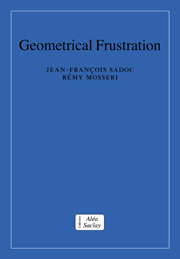Crossref Citations
This Book has been
cited by the following publications. This list is generated based on data provided by Crossref.
Soyer, Alain
Chomilier, Jacques
Mornon, Jean-Paul
Jullien, Rémi
and
Sadoc, Jean-François
2000.
Voronoï Tessellation Reveals the Condensed Matter Character of Folded Proteins.
Physical Review Letters,
Vol. 85,
Issue. 16,
p.
3532.
Sadoc, J.F
and
Rivier, N
2000.
Boerdijk–Coxeter helix and biological helices as quasicrystals.
Materials Science and Engineering: A,
Vol. 294-296,
Issue. ,
p.
397.
Doye, Jonathan P. K.
and
Wales, David J.
2001.
Polytetrahedral Clusters.
Physical Review Letters,
Vol. 86,
Issue. 25,
p.
5719.
Ziherl, P.
and
Kamien, Randall D.
2001.
Maximizing Entropy by Minimizing Area: Towards a New Principle of Self-Organization.
The Journal of Physical Chemistry B,
Vol. 105,
Issue. 42,
p.
10147.
Ranganathan, S.
Subramaniam, A.
Tsai, A. P.
and
Dong, C.
2001.
BCC derivative structures and their relation to rational approximants to quasicrystals.
Ferroelectrics,
Vol. 250,
Issue. 1,
p.
201.
Angelov, Borislav
Sadoc, Jean‐François
Jullien, Rémi
Soyer, Alain
Mornon, Jean‐Paul
and
Chomilier, Jacques
2002.
Nonatomic solvent‐driven voronoi tessellation of proteins: An open tool to analyze protein folds.
Proteins: Structure, Function, and Bioinformatics,
Vol. 49,
Issue. 4,
p.
446.
Klein, D. J.
2003.
Quasilocal defects in regular planar networks: Categorization for molecular cones.
International Journal of Quantum Chemistry,
Vol. 95,
Issue. 4-5,
p.
600.
Rault, Jacques
2003.
T g in Confined Systems: A Free Volume Approach.
Journal of Macromolecular Science, Part B,
Vol. 42,
Issue. 6,
p.
1235.
Cornwell, J F
2004.
On the Structure of Icosahedral Quasicrystals.
Physica Scripta,
Vol. 69,
Issue. 5,
p.
410.
Klein, D.J.
and
March *, N.H.
2004.
The role of disclinations in two phase changes induced by temperature and pressure in crystalline solids: melting and the brittle–ductile transition.
Physics and Chemistry of Liquids,
Vol. 42,
Issue. 5,
p.
545.
Tarjus, G
Kivelson, S A
Nussinov, Z
and
Viot, P
2005.
The frustration-based approach of supercooled liquids and the glass transition: a review and critical assessment.
Journal of Physics: Condensed Matter,
Vol. 17,
Issue. 50,
p.
R1143.
Angelov, Borislav
Angelova, Angelina
Papahadjopoulos-Sternberg, Brigitte
Lesieur, Sylviane
Sadoc, Jean-François
Ollivon, Michel
and
Couvreur, Patrick
2006.
Detailed Structure of Diamond-Type Lipid Cubic Nanoparticles.
Journal of the American Chemical Society,
Vol. 128,
Issue. 17,
p.
5813.
Cvetkovic, V.
Nussinov, Z.
and
Zaanen, J.
2006.
Topological kinematic constraints: dislocations and the glide principle.
Philosophical Magazine,
Vol. 86,
Issue. 20,
p.
2995.
Rivier, N.
and
Sadoc, J. F.
2006.
The transverse structure of collagen.
Philosophical Magazine,
Vol. 86,
Issue. 6-8,
p.
1075.
Klein, Douglas J.
and
Balaban, Alexandru T.
2006.
The Eight Classes of Positive-Curvature Graphitic Nanocones.
Journal of Chemical Information and Modeling,
Vol. 46,
Issue. 1,
p.
307.
Rivier, N.
and
Sadoc, J.-F.
2007.
Topology in Molecular Biology.
p.
147.
Modes, Carl D.
and
Kamien, Randall D.
2007.
Hard Disks on the Hyperbolic Plane.
Physical Review Letters,
Vol. 99,
Issue. 23,
Charvolin, Jean
and
Sadoc, Jean-François
2007.
Disclinations in systems of amphiphilic molecules: Cubic structures.
Comptes Rendus. Chimie,
Vol. 11,
Issue. 3,
p.
198.
Sausset, F
and
Tarjus, G
2007.
Periodic boundary conditions on the pseudosphere.
Journal of Physics A: Mathematical and Theoretical,
Vol. 40,
Issue. 43,
p.
12873.
Glicksman, M. E.
and
Rios, P. R.
2007.
Minimal network partitions using average -hedra.
Philosophical Magazine,
Vol. 87,
Issue. 2,
p.
189.



